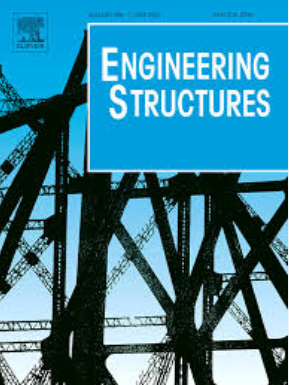A virtual joints based transfer matrix method for dynamic performance analysis of periodic beams
IF 5.6
1区 工程技术
Q1 ENGINEERING, CIVIL
引用次数: 0
Abstract
An updated Transfer Matrix (TM) method involving spatial discretization through the introduction of virtual joints is proposed for the dynamic analysis of periodic structures with long transfer distances. The root cause of numerical issues in the TM method arising from long transfer distances is identified. This issue is effectively addressed by discretizing the original beam segments with virtual joints. The Joint Coupling Matrix (JCM) method is used to universally describe the restraints and interactions at all joints, leading to the closed-form solutions for the dynamic responses of periodic beams. To validate the updated TM method, the natural frequencies and forced vibration responses calculated from the updated TM method are compared with those from Finite Element Method (FEM). Then, the updated TM method is used to investigate the vibration mitigation performance of periodic structures. Results from both free and forced vibration analyses reveal the variation characteristics of natural frequencies with structural periodic parameters and elucidate the relationship between the vibration mitigation performance of periodic beams and the loading frequencies. Furthermore, through Frequency Response Function (FRF) analysis, the vibration mitigation mechanism of periodic beams is examined in depth from a vibration perspective. This work provides valuable guidance for the optimal parameter configuration of periodic structures to achieve enhanced vibration mitigation performance.
基于虚拟节点的周期梁动力性能分析传递矩阵法
提出了一种通过引入虚拟关节进行空间离散化的更新传递矩阵方法,用于长传递距离周期结构的动力分析。确定了由于长距离传输引起的TM方法数值问题的根本原因。利用虚拟节点对原梁段进行离散化,有效地解决了这一问题。采用关节耦合矩阵(JCM)方法,统一描述了各节点的约束和相互作用,得到了周期梁动力响应的封闭解。为了验证更新的TM方法,将更新的TM方法计算的固有频率和强迫振动响应与有限元法计算的结果进行了比较。然后,采用改进的TM方法对周期结构的减振性能进行了研究。自由振动和强迫振动分析的结果揭示了周期梁固有频率随结构周期参数的变化特征,阐明了周期梁减振性能与加载频率的关系。此外,通过频响函数分析,从振动角度深入探讨了周期梁的减振机理。该研究为优化周期结构的参数配置,提高周期结构的减振性能提供了有价值的指导。
本文章由计算机程序翻译,如有差异,请以英文原文为准。
求助全文
约1分钟内获得全文
求助全文
来源期刊

Engineering Structures
工程技术-工程:土木
CiteScore
10.20
自引率
14.50%
发文量
1385
审稿时长
67 days
期刊介绍:
Engineering Structures provides a forum for a broad blend of scientific and technical papers to reflect the evolving needs of the structural engineering and structural mechanics communities. Particularly welcome are contributions dealing with applications of structural engineering and mechanics principles in all areas of technology. The journal aspires to a broad and integrated coverage of the effects of dynamic loadings and of the modelling techniques whereby the structural response to these loadings may be computed.
The scope of Engineering Structures encompasses, but is not restricted to, the following areas: infrastructure engineering; earthquake engineering; structure-fluid-soil interaction; wind engineering; fire engineering; blast engineering; structural reliability/stability; life assessment/integrity; structural health monitoring; multi-hazard engineering; structural dynamics; optimization; expert systems; experimental modelling; performance-based design; multiscale analysis; value engineering.
Topics of interest include: tall buildings; innovative structures; environmentally responsive structures; bridges; stadiums; commercial and public buildings; transmission towers; television and telecommunication masts; foldable structures; cooling towers; plates and shells; suspension structures; protective structures; smart structures; nuclear reactors; dams; pressure vessels; pipelines; tunnels.
Engineering Structures also publishes review articles, short communications and discussions, book reviews, and a diary on international events related to any aspect of structural engineering.
 求助内容:
求助内容: 应助结果提醒方式:
应助结果提醒方式:


